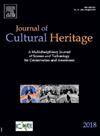A site-wide and comprehensive assessment of salt-induced tuff deterioration in the Archaeological Park of Herculaneum
IF 3.3
2区 综合性期刊
0 ARCHAEOLOGY
引用次数: 0
Abstract
The Archaeological Park of Herculaneum, buried by the 79 CE eruption of Mount Vesuvius, faces a significant conservation challenge, the degradation of the volcanic tuff walls. Building upon previous studies, this work presents the first large-scale assessment of this degradation phenomenon, employing a comprehensive analytical approach that extends across the entire archaeological park. In detail, this study combines in-situ and laboratory analyses to investigate the origin and composition of the soluble salts that take part in this degradation process. Thermographic imaging identified moisture accumulation at the base of walls, confirming the capillary rise of humidity from the soil. Raman and FT-IR spectroscopy revealed that sodium sulfate, in both anhydrous (thenardite) and hydrated (mirabilite) forms, is the predominant salt, with additional contributions from calcium sulfate and minor nitrates. Ion chromatography of soil samples confirmed significant spatial and seasonal variations, with sulfates more concentrated in northern areas and increasing overall in winter. The results demonstrate that a combined approach using ion chromatography, thermographic imaging, and handheld Raman spectroscopy provides an efficient diagnostic tool for assessing salt-related deterioration. This protocol could be extended to other archaeological sites to guide conservation strategies and mitigate the impact of salt-induced decay on built heritage.
赫库兰尼姆考古公园盐致凝灰岩变质的全区综合评估
赫库兰尼姆考古公园被公元79年的维苏威火山喷发所掩埋,面临着一个重大的保护挑战,即火山凝灰岩壁的退化。在先前研究的基础上,这项工作首次对这种退化现象进行了大规模评估,采用了一种全面的分析方法,延伸到整个考古公园。详细地说,这项研究结合了现场和实验室分析来研究参与这一降解过程的可溶性盐的来源和组成。热成像发现了墙壁底部的水分积累,证实了土壤湿度的毛细管上升。拉曼光谱和红外光谱显示,无水(芒硝)和水合(芒硝)形式的硫酸钠是主要的盐,硫酸钙和少量硝酸盐也有额外的贡献。土壤样品的离子层析证实了显著的空间和季节变化,硫酸盐在北部地区更集中,冬季总体增加。结果表明,离子色谱、热成像和手持式拉曼光谱相结合的方法为评估盐相关的变质提供了有效的诊断工具。该协议可以扩展到其他考古遗址,以指导保护策略并减轻盐引起的腐烂对建筑遗产的影响。
本文章由计算机程序翻译,如有差异,请以英文原文为准。
求助全文
约1分钟内获得全文
求助全文
来源期刊

Journal of Cultural Heritage
综合性期刊-材料科学:综合
CiteScore
6.80
自引率
9.70%
发文量
166
审稿时长
52 days
期刊介绍:
The Journal of Cultural Heritage publishes original papers which comprise previously unpublished data and present innovative methods concerning all aspects of science and technology of cultural heritage as well as interpretation and theoretical issues related to preservation.
 求助内容:
求助内容: 应助结果提醒方式:
应助结果提醒方式:


